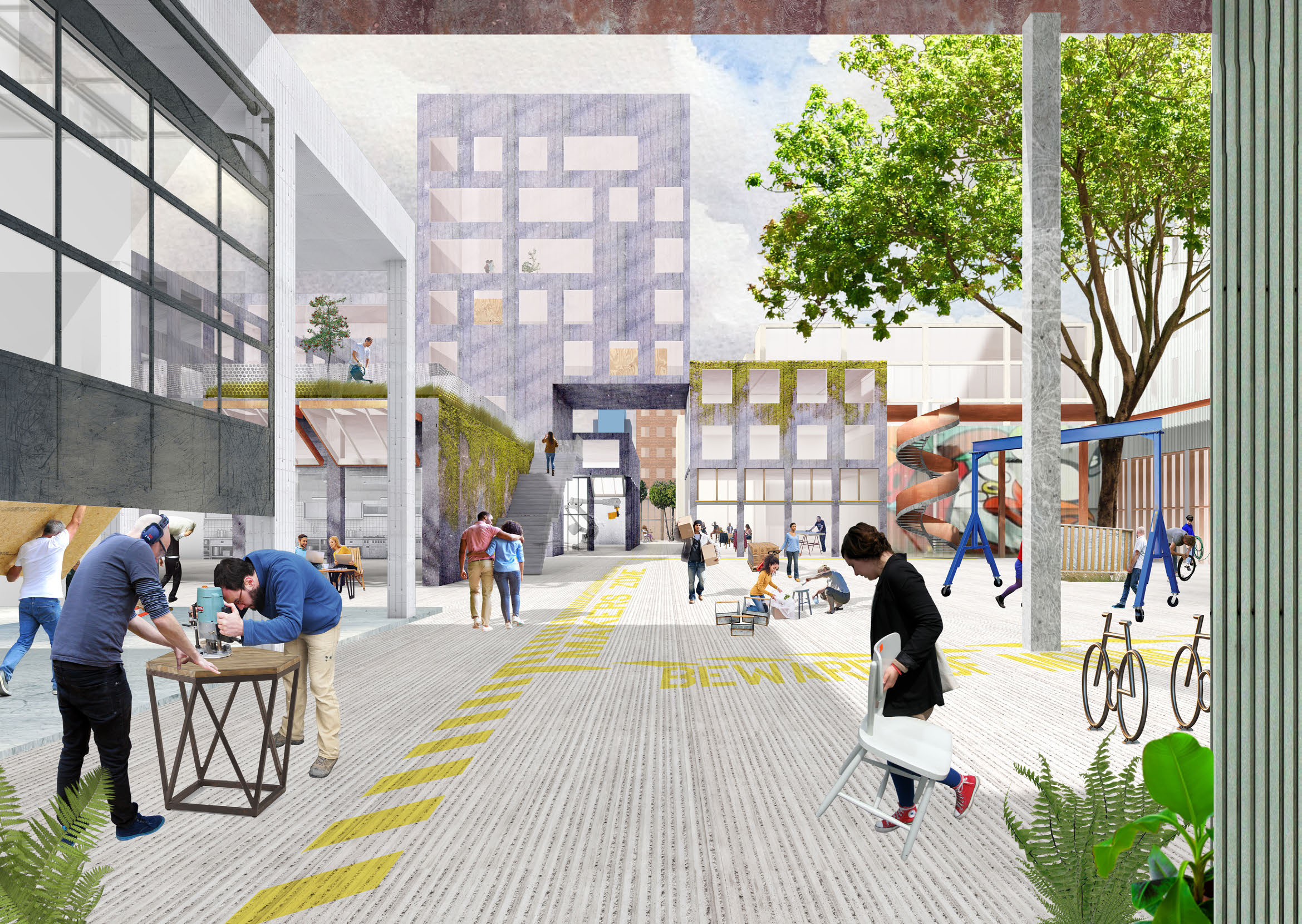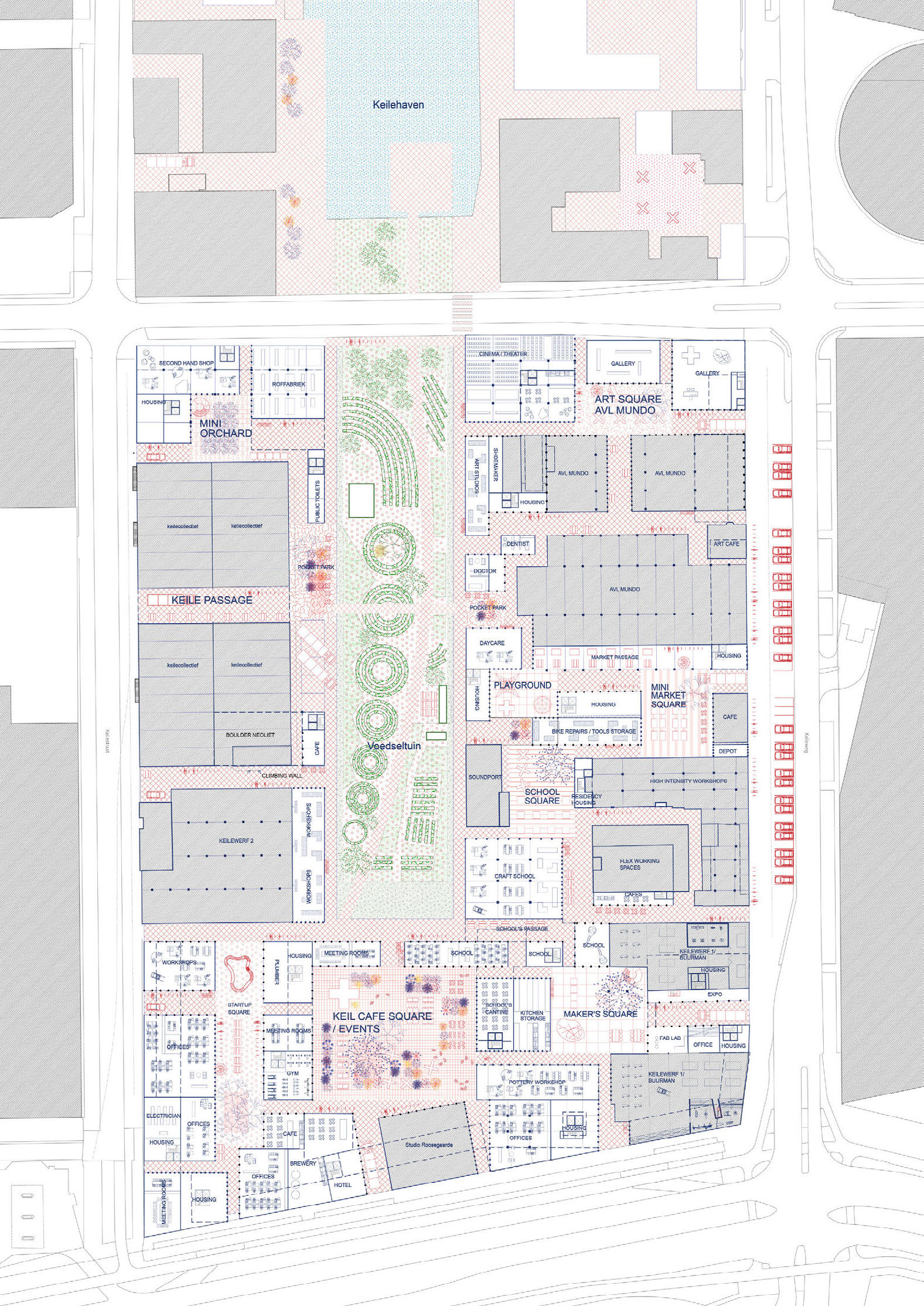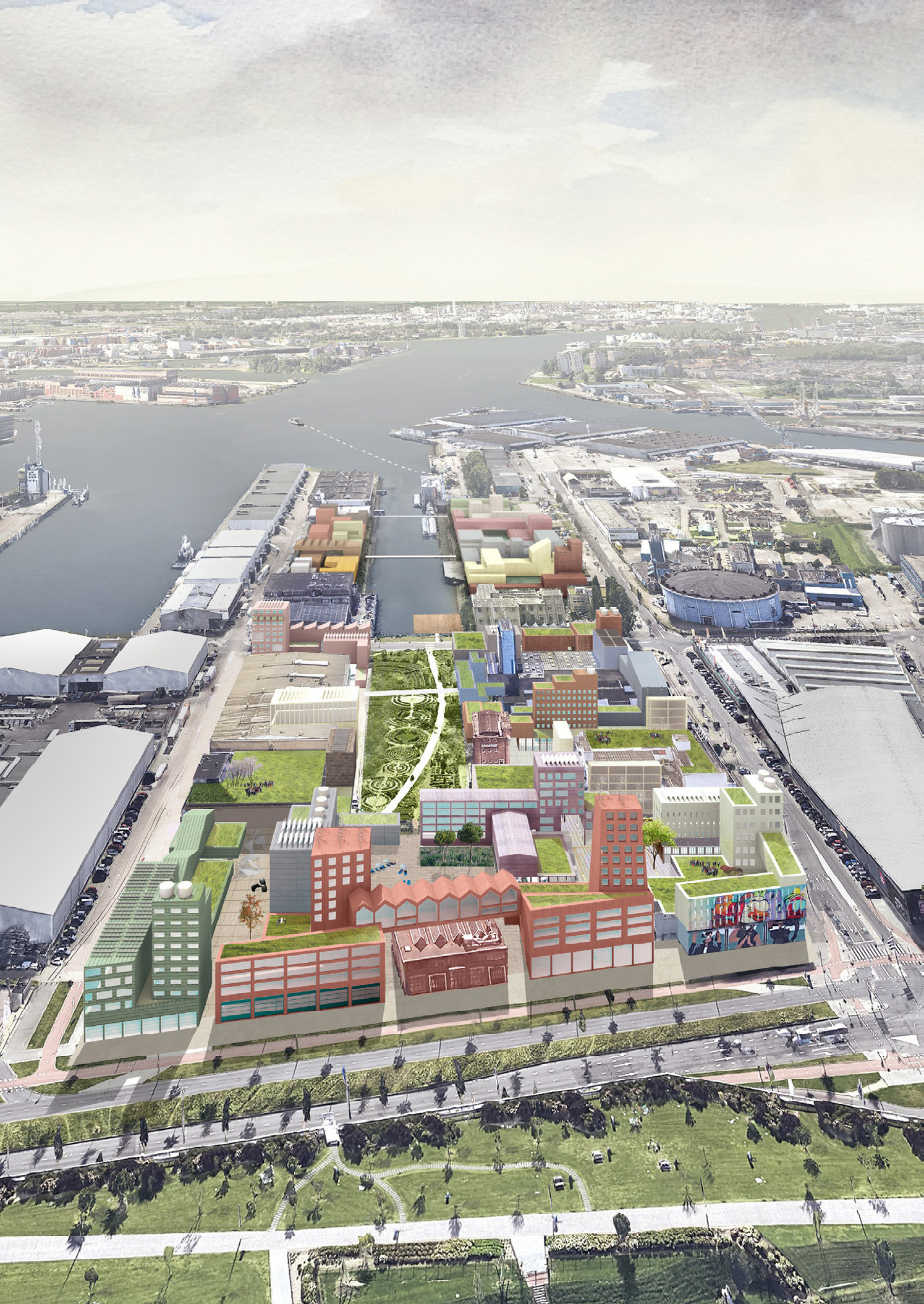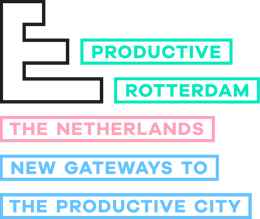Makers’ Maze: Making Space for Organic Growth

Vierhavensblok Makers’ Square
Collage: Makers’ Maze Team
In the winning proposal for Rotterdam’s Europan 15 Vierhavensblok site, Makers’ Maze, architecture is reconnected with the economic, social and political realities of the contemporary city by offering a flexible method, rather than a rigid design. The proposal’s ambition is to create new conditions for creativity, circularity, interaction, sharing, and freedom while preserving the existing. The charm of the Vierhavensblok is its informal character where participants discover the unexpected around each corner, and where chance encounters breed new collaborations. Inspired by these qualities, the proposal presents a series of interlocking building clusters organised around a network of passages, streets and squares, creating a unified, resilient, and intriguing urban scheme. The design solution makes spaces for organic growth, and its combination of new manufacturing industry, urban facilities, housing, culture, and a circular economy lays the foundation for an interactive, and forward thinking area, as well as a new testing ground for Rotterdam: the port city of the future.
Makers’ Maze Team Interview
Videography: Kristel Kuiper; Interview: Cullo Studio for AIR
Inspecting the existing
The Vierhavensblok area has enjoyed a rich history as a productive Rotterdam district. Building on its industrial character and manufacturing past, this area is in a strong position to become a more integral part of the city. Stimulating this transition are new modes of working and living, the rapid development of new technologies, and a renaissance in craftsmanship (albeit in a modern, digitized and innovative form). Vierhavensblok is already responding to requirements by functioning as a microcosmic, post-industrial niche full of makers and production activities led by creative and cultural entrepreneurs.
On this industrial headline there is enough space for Keilcollectief, Voedseltuin, Soundport, AVL Mundo, Studio Roosegaarde, Buurman and the many other tenants of the Keilewerf. The power of their self-initiative, cooperation and exchange is enormous. These organisations have adopted and adjusted the existing space to suit their needs and have ambition to remain in place. However, these hopes are laced with insecurity: the area is marked for densification due to current pressure to increase housing stock in Rotterdam, and if they are to remain in place, a well defined future vision for the site is needed. Therefore, the question shifts from how do you create the ideal environment for makers, to how do you preserve the identity of this ideal place while answering the demands of the greater city?
It is no coincidence that the area attracts makers. Affordable, flexible warehouses provide ample space for innovative new industries, while outdoor spaces support the buildings’ functions by providing enough room for storage and delivery. The striking vacant site quality is juxtaposed with few existing buildings. It takes some time to discover its narrow passages, workyards, and alleys hidden behind or nestled in between long facades, sheds, and fences. While not yet easily accessible, these features have great potential to become a walkable, intriguing piece of the city fabric. This redevelopment’s main task is to ensure that existing makers remain in place, and introduce additional functions while, at the same time, augmenting existing area qualities so residents can continue to shape and influence their own environment.

Masterplan Vierhavensblok
Drawing: Makers’ Maze Team
Extrapolating the current state
The objectives are clear: first, the existing buildings and users will remain in place, either indefinitely, or until new purpose-built spaces are available to accommodate them on-site. The makers, Voedseltuin, workshops and companies need not look for another location. Secondly, this proposal explores existing architecture, and urban qualities and then aggregates them, to create a base for new developments. The solution distributes passages, alleys, inner streets, squares and courtyards throughout the site changing scale from industrial to urban. It facilitates more connections and new entrances, promoting a walkable, space of a human scale that is designed around public and semi-public areas, not buildings. These outdoor spaces are well-defined from project onset and create an interconnected network: the Makers’ Maze.
Courtyards, streets and rooftops are hidden from the exterior as they organise the new public interior. This is a space that encourages creativity, productivity and focus. This exciting labyrinth invites visitors to learn and discover, and is designed for walking or cycling only, with vehicular traffic restricted to business/workshop services. The outdoor space is as essential as indoor space, if not more. Therefore, the Voedseltuin retains its function as a productive permaculture garden and will be surrounded by, yet not entirely unified with, the old and newly interdigitated building fabric. By juxtaposing the open, vast scale of the garden, water, and the industrial area, with the small, intimate scale of alleys and squares, their substance gains new prominence and their quality enhanced.
The increased density of workspaces on the ground floor facilitates conditions for interaction and exchange: workshops, makers and other logistics are allocated space (inside and outside), while housing, shared spaces and some commercial areas are located on upper floors. This creates a multi-layered, resilient, and diverse city fabric. There are no live-work units as such, where office and home are combined. Instead, the solution ensures a healthy commute: each resident must leave their home and go outside to go to work — at another area of the site. Workshop users can live within the Vierhavensblok, and housing is reserved for them. The Makers’ Maze is not a collection of diverse buildings, but one large and interconnected ecosystem, where energy, water, working space, and waste solutions are shared. Its system becomes a method rather than rigid design. This engenders change, diversity, and incongruity.

Section Vierhavensblok Makers’ Square
Drawing: Makers’ Maze Team
Place-defining clusters
The streets and squares of the masterplan are defined by the surrounding architectural volumes, both new and existing. Drawing inspiration from the existing buildings on the site (and the surrounding area, such as the Emaillefabriek), the proposed architectural strategy is not composed of autonomous buildings, but rather of interconnected clusters of diverse volumes and functions. Surrounding and defining public spaces, they consist of blocks of different shapes and heights. Each cluster has a colour / materiality that makes it identifiable within the plan and, in the case of clusters taking form around existing buildings, their facade materials are based on existing workshops that anchor each cluster. Materials can be shared and mixed within a cluster as long their appearance and colour facilitate definition. Clusters work as showcases of materials and provide a means to organise, categorise and label them. Existing workshops are no longer temporary, but rather they become an integral part of the foundation of the plan. New volumes are attached to them or are cantilevered above them. Besides providing additional floor space, these new structures also provide access to rooftops, which are used as communal gardens with shared functions attached: laundry rooms, storage, flex offices, game rooms, labs etc. Layers of shared spaces work as buffers between the living and working zones to create a diverse, mixed urban fabric that extends not only horizontally, but also vertically. The centre of the plan retains the Voedseltuin as an anchor: it serves as a ‘central park’ of sorts — a green, productive and philanthropic heart of the area.
Participants and their spaces
With a strong focus on re-making, reusing, and re-inventing, the types of professions that activate the area range from woodworkers and 3D fab-labs, to plumbers and shoemakers. By combining new-school semi-industrial uses with more traditional ones, this bypasses the pitfalls typical of gentrification while maintaining and building on existing activities on site.
This proposal addresses the urban and architectural scales to reimagine the neighborhood as a resilient machine that accommodates working, living, playing and resting. It is built on circular principles of enduring design, reuse, refurbishment, and recycling. The main challenge to its success is integrating new developments while maintaining a sense of community between the existing and new residents. By organising the site into interlocking
clusters, the community spirit is spatially supported, because the scale shifts along with the users. Old relationships remain, but new ones become an added layer and each participant plays their own role in the success of the site. A programmatic mix of 30-40% businesses, 10-20% offices, 30-50% housing, and 10% services is easy to achieve and adjust, because the clusters are developed not in tandem, but one by one, allowing for small adjustments based on market pressures. The proposal for Maker’s Maze considers potential friction that might occur when noisy working spaces and peaceful residential neighbourhoods are combined. Therefore, functions are organised gradually and according to their intensity. Squares serve as space for storing and delivering materials and for low noise activities. Especially noisy or disruptive machines are placed into additionally sound isolated boxes inside warehouses. Buffer programming like offices, showrooms or shared rooftops create a physical break between the workshops and living programs. The housing floors built on top of existing workshops are suspended above them (with an air gap and extra insulation).
Circularity, sharing & sustainability
In the circular city, there is little to no waste. Collaboration and information sharing create new, interesting connections that lead to ground-breaking circular initiatives. People living in the area trade in their furniture or other objects for renovation, or donate them as a material to the workshops. Thus, materials are exchanged between the craft school, workshops, businesses and households for reuse and repurposing. The proposal includes a secondhand shop where individuals can deposit old furniture and other objects and other inhabitants or visitors can purchase them. There are many small businesses on the site: plumbers, electricians, and shoemakers who work locally to help repair, sort, reuse and exchange households, office, and workshop objects.
The new buildings in the clusters themselves are composed of recycled materials. Where possible, demolished buildings from the transformed industrial area provide material for new structures, whether it is recycled concrete, rubble for roads or recycled bricks. Added structures are designed in a way that makes it easy to reuse their parts with facades and other elements designed for disassembly. Each new cluster comes with a building passport and BIM model when complete, to ensure that all material information is readily available to support a full building life-cycle.

Aerial Vierhavensblok
Render: Makers’ Maze Team
Guiding principles
8 principles for sustainable urban development support the M4H redevelopment. This proposal focuses on the goals of collectivity and circularity which the design solution articulates.
M4H builds on the industrial capacity and quality of the area, offers permanent space to different types of makers, room for experimentation and learning, and favours the sharing of facilities over individual ownership.
Therefore, this proposal’s building clusters are an interpretation of what already exists on site: an assembly of buildings interlocking around outdoor spaces. The quality of the current situation is discovered, understood and used as this logic becomes the guiding principle for the new site architecture and public spaces. By retaining existing users on site, and strategically adding others as the project expands, a rich mix of different kinds of makers will develop within the ‘Maze’. New spaces are ambiguous, encouraging participation and initiative, creating a perfect environment for learning and exchange. Besides established companies, there is space for a craft school to teach vocations to a younger generation of makers and fabrication laboratories where students and residents can explore and innovate. The school prepares interns and starters alike for success in the surrounding companies. This vibrant proximity of artists, makers, students, architects, and activists in a single space creates an enormous force where innovation has a room to thrive.
The proposal also addresses other points concerning sustainability, as the site functions according to a leading principle of circularity and the reuse of materials. Thanks to a diverse mix of various residents’ initiative, skills, and ideas for creative reuse are easy to find. Inhabitants can find electric shared cars in designated parking spaces, park bikes easily in every alley or square, or opt for using adjacent Marconiplein metro station and other public transport options. Use and exchange of renewable energy is done through solar panels and solar heating on the non-accessible roofs. Other rooftops create a network of green spaces that buffer rainwater runoff, increase biodiversity, and create space for urban rooftop gardening. The outdoor space is climate-adaptive, using permeable paving where possible, and the strategic placement of trees and buildings to enhance natural cooling effects.
Making it possible
If cities wish to remain inclusive, they must generate ideal environments that stimulate productive neighborhoods, by integrating existing production space with new residential units. Semi-industrial space is under seige in cities across the world, and pushed to the periphery, in the name of profit. However, these areas are an integral part of the lively city fabric and should be celebrated as such. Creative manufacturing, a mix of design, prototyping, making and marketing, is a popular typological mix. This industry needs spaces that are part office, part testing lab, and part production floor, an increasingly difficult configuration to find. Because rent for production space is lower than office space, it is less profitable and thus unsupported by the market if there is no public policy to protect it. If these vibrant spaces are to be created, work space must be available across price segments while also supporting social facilities for the community – such as medical practices, crèches, and community centres. In order to offset the development of lower rent spaces and social housing, this proposal provides a healthy mix of high end typologies as well – restaurant spaces, high end offices, city lofts and a hotel. Thanks to the layered design with many accessible roof gardens serving as an extension of public space, upper floors of the buildings may be commercial spaces, restaurants, and services while many ground floors spaces can accommodate workshop activities, without compromising the financial balance of the development.
Makers’ Maze
The future of the site calls for careful orchestration in its redevelopment. Unchecked gentrification could easily compromise a delicate balance between makers and developers. The city, of course, relies on investment to grow but the success of this investment is reliant on the creation of a vibrant urban life that is inclusive, balanced, and diverse. It would be impossible to design everything – because a certain amount of organic growth is necessary. Jane Jacobs ardently supported experimentation in urban environments. She understood that complexity and disorder are charming and breed creativity in the city. Therefore, this proposal establishes a framework that builds on the existing character of the site, while increasing the resilience of Vierhavensblok through the creation of an adaptable and diverse section of the city. The combination of new manufacturing industry, urban facilities, housing, culture, and a circular economy lays the foundation for an interactive, and forward thinking area, as well as a new testing ground for Rotterdam: the port city of the future.
Izabela Slodka, Architect (PL); Erica Chladova, Architect (CZ)
Makers’ Maze: Winner Vierhavensblok


